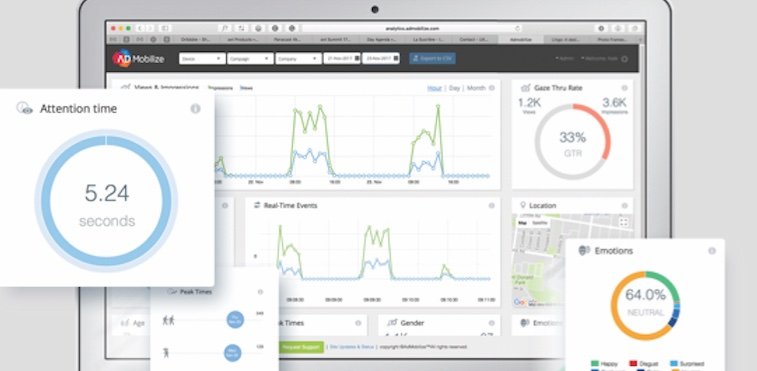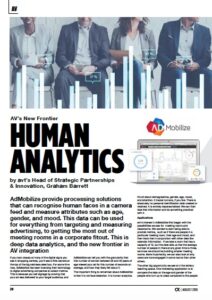News
29 Oct 2018
Human Analytics – AV’s New Frontier

Subscribe to CX E-News
AV
Human Analytics – AV’s New Frontier
by Graham Barrett, Head of Strategic Partnerships & Innovation, avt
 AdMobilize provide processing solutions that can recognise human faces in a camera feed and measure attributes such as age, gender, and mood. This data can be used for everything from targeting and measuring advertising, to getting the most out of meeting rooms in a corporate fitout.
AdMobilize provide processing solutions that can recognise human faces in a camera feed and measure attributes such as age, gender, and mood. This data can be used for everything from targeting and measuring advertising, to getting the most out of meeting rooms in a corporate fitout.
This is deep data analytics, and the new frontier in AV integration.
If you look closely at many of the digital signs you see in shopping centres, you’ll see a little camera at the top of the big stainless steel box. For some time now, AdMobilize has been licensing their technology to digital advertising companies to collect metrics.
 This is because you sell signage by proving that your ad was delivered to your target audience, and AdMobilize can tell you with the granularity that this number of women between 25 and 40 years of age viewed your ad for this number of seconds on average, and how they likely felt about it. The important thing to remember about AdMobilize is that it is not face detection. It is human analytics.
This is because you sell signage by proving that your ad was delivered to your target audience, and AdMobilize can tell you with the granularity that this number of women between 25 and 40 years of age viewed your ad for this number of seconds on average, and how they likely felt about it. The important thing to remember about AdMobilize is that it is not face detection. It is human analytics.
It’s all about demographics, gender, age, mood, and attention. It tracks humans, if you like. There is absolutely no personal identification data created or retained. It is entirely depersonalised. We can then take that information and do something practical with it.
Applications
avt’s interest in AdMobilize first began with the possibilities we saw for meeting rooms and classrooms. We wanted to start being able to provide metrics, such as if there are people in a particular meeting room, their age and mood, and then track that in conjunction with other data like calendar information.
If we take a room that has a capacity of 12, but the data tells us that the average number of people in there at any given time is three, we know we should be building smaller meeting rooms. More importantly, we can also look at why users are more engaged in some rooms than other others.
The other big opportunity we see is in the tertiary teaching space. One interesting application is to compare the data on the age and gender of the people who turn up to class compared to the people who are actually enrolled. There’s also the ability to track the average class engagement for a particular academic. We’ve already done some really exciting trials with QUT who are collecting data on a range of classrooms.
Possibilities
When we combine AdMobilize with our Tripleplay digital signage products, we get the ability to provide human-driven signage. This allows our integration partners to deliver that in a much less bespoke and high-cost manner than if you were going through an ad agency, and drive user experience based around the engagement, attention, gender and demographics of the audience.
Tripleplay have very robust and very open APIs that have allowed us to do projects very easily. You can access just about every part of the platform via an API. And when we’re talking about something like an experiential environment, it might be you want to play video rather than run a particular piece of signage.
This means we have an API from Tripleplay into video-on-demand, and the video that just played is based on the audience measurements from AdMobilize. We can have the demographic of the audience drive exactly what’s displayed on screens. You’re not just limited to digital signage.
Practicalities
AdMobilize was designed to work on very inexpensive webcams. In a room, you want to make sure that you get everyone in shot, and therefore contributing to the data. You’ve got to be a little bit mindful of the algorithms in use; AdMobilize works by learning what a face is. If you distort that face that can significantly reduce the accuracy of the data.
There are some strict requirements in terms of depth of field and the number of pixels that make up a face. There’s also limitations in terms of how far away the people are from the camera. AdMobilize also make a crowd analysis product, which is quite impressive, because that is all about what makes a human, not just a face.
In the case of a crowd, you can have someone who has their back or their side to the camera, and AdMobilize can still determine that they are a person, which way they’re moving, or whether they’re staying in a particular area.
AdMobilize use a couple of different licensing models. The first is when you stream video from several cameras to a central server, and then have multiple instances of AdMobilize running on that server. The more common approach is to have the camera and computer local to the display, which ends up being quite cost-effective until you get into massive scale.
Irrespective of the platform, both of those examples then connect to the AdMobilize cloud solution, which is where the actual diagnostics and data is turned into the dashboard view you get as a client.
The Future
It’s all about the data. The real value for signage is in being able to say ‘It’s predominantly young people in this particular area; let’s send this content.’ In education, it’s being able to say ‘Students are engaged with this course, but not that one. Let’s make a change’. We see this as the future of AV. Our customers are going to be asking us to provide data and analytics about how effective the technology we sell really is. And with AdMobilize and Triplelplay, we can actually do it today.
This article first appeared in the October 2018 edition of CX Magazine – in print and online. CX Magazine is Australia and New Zealand’s only publication dedicated to entertainment technology news and issues. Read all editions for free or search our archive www.cxnetwork.com.au
© CX Media
Subscribe
Published monthly since 1991, our famous AV industry magazine is free for download or pay for print. Subscribers also receive CX News, our free weekly email with the latest industry news and jobs.









